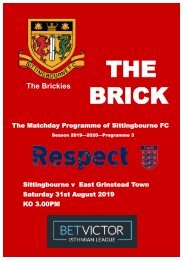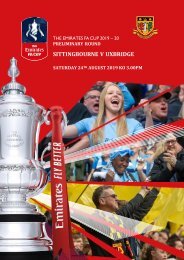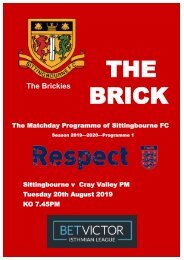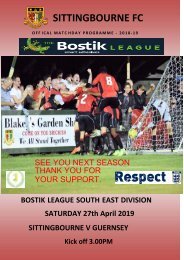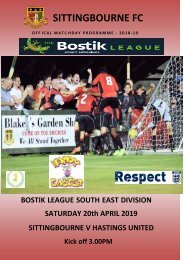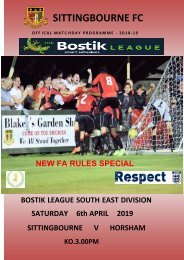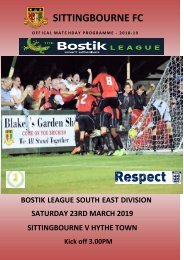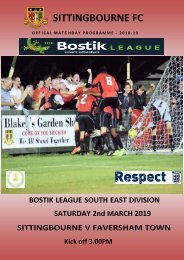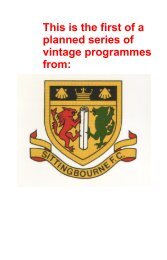Hythe191019_Complete
You also want an ePaper? Increase the reach of your titles
YUMPU automatically turns print PDFs into web optimized ePapers that Google loves.
A series of articles by the author of the book ‘A History and Guide to Football Programmes’<br />
describing how programmes have changed over a century-and-a-half of Association<br />
Football. These articles will appear throughout the season in the Sittingbourne FC<br />
programme.<br />
Everybody’s Doing It in the 1920’s<br />
Programme issuing by clubs and associations became the norm in the 1920’s, resulting from the<br />
example shown by those clubs whose pre-Great War programmes had proved to be good<br />
sellers, and significant profit makers. Another reason for the explosion of issues was the widespread<br />
provision of “Half Time Scoreboards” around football grounds.<br />
In the days before radio coverage and teletext, football crowds had to rely on the “half times”<br />
from other grounds being displayed on enormous fixed boards (either at the back of the terracing<br />
or at the trackside), to ascertain how rivals were faring. The only means of deciphering the mixture<br />
of letters and numbers was to refer to the coded list of fixtures printed in the match programme.<br />
In this way, the programme had evolved from being a means of identification of players<br />
to being a vehicle for even more spectator information.<br />
Part of the sudden upsurge in programme production was the virtual doubling of the size of the<br />
Football League in the early 1920’s, by the formation of Division 3 North and the transfer of clubs<br />
from the Southern League to form Division 3 South. Thus we have the first regular issue of programmes<br />
from Rochdale in 1922/23, Halifax Town in 1921/22 and such long forgotten ex-League<br />
clubs as Wigan Borough and Stalybridge Celtic (both 1921/22) and Nelson (1924/25). Of clubs to<br />
join the League in subsequent years, York City issued an 8-page programme in 1924/25 in the<br />
Midland League, and Torquay United first issued (starting with FA Cup ties) in 1923/24.<br />
Chelsea, host club of the 1920, 1921, and 1922 FA Cup Finals, set a fine example by publishing<br />
the first truly official, and substantial, FA Cup Final programmes. Featuring classical sketches by<br />
Bernhard Hugh on the cover, these were 24, 20 and 8-page programmes respectively, the last<br />
bearing a very close resemblance to the standard Chelsea programme of the inter-war years.<br />
The 1920’s was the decade in which football programme production became the norm throughout<br />
the Football League, and for all major non-league clubs, and it was also the era in which programmes<br />
adopted the format we associate with them today. Henceforth, match programmes<br />
would be multi-page, stapled, liberally filled with advertisements and including as a minimum;<br />
team selections, fixtures/results, league tables, half-time scoreboard and editorial.<br />
For more information and advice on programmes and programme collecting, please visit<br />
www.pmfc.co.uk.








